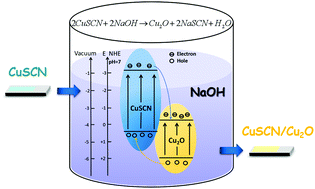In situ growth of a P-type CuSCN/Cu2O heterojunction to enhance charge transport and suppress charge recombination†
Abstract
High charge transport and low charge recombination rates are crucial to p-type copper thiocyanate (CuSCN) for practical applications. However, most of the current studies are focused on improving charge separation by constructing a heterojunction, losing sight of charge recombination at the heterojunction interface. In this work, we propose a new strategy of in situ growth of a CuSCN/Cu2O heterojunction using a simple alkali treatment technique, to promote charge transport and suppress interface recombination. As a result, the carrier lifetime is improved by one order of magnitude from 0.18 ms of pure CuSCN to 6.7 ms of CuSCN/Cu2O. The number of extracted photogenerated carriers per square centimeter is increased by almost 11 times, from 1.34 mC cm−2 for pure CuSCN to 14.69 mC cm−2 for CuSCN/Cu2O at 0 s decay time. Finally, in situ growth of CuSCN/Cu2O successfully achieves a high charge transport rate and low charge recombination compared with pure CuSCN. The superior performance for in situ growth of CuSCN/Cu2O bilayered films will open new opportunities for a broad range of applications, including photoelectrochemical water splitting, dye-sensitized solar cells, and perovskite solar cells.



 Please wait while we load your content...
Please wait while we load your content...